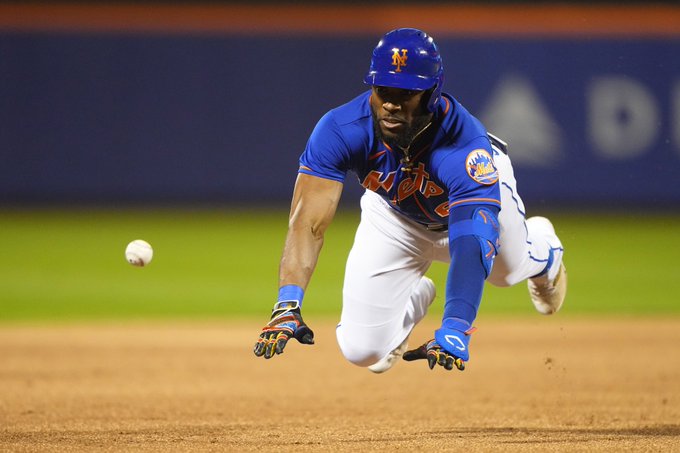
Photo via USA Today.
As Mets fans, we have seen baseball’s new rules in action for five games so far. When Major League Baseball decided it was time for a pitch clock, larger bases, shift restrictions, and a set number of pitcher “disengagements” per plate appearance with runners on base, the powers that be had certain objectives in mind. They wanted crisper games with less “dead air,” more offense (especially balls put in play), and even more stolen bases. Small sample size notwithstanding, it’s fair to ask, “how’s it all going?”
The early returns are in, as documented in an article in The Athletic by Levi Weaver and Ken Rosenthal, and a recent tweet by Jeff Passan. First, let’s look at the all-important time-of-game and the pitch clock.
How the Pitch Clock Has Gone
Using game length as the metric, the pitch clock is a rousing success. Passan notes that through 49 games last year, games averaged three hours and nine minutes. Over the first 50 games of this season, games averaged two hours and 38 minutes. To rationalize the implementation of the pitch clock, MLB pointed to minor league results where the clock shortened games by close to thirty minutes. So far, we are seeing a similar result in MLB. How about the Mets’ game on March 31 that lasted just two hours, and nine minutes (granted, only three runs were scored)? Haven’t seen that in a long time.
How About the Shift?
Have there been more hits? Yes, in fact, there have been. Rosenthal and Levi report that last year on Opening Day, games averaged 14.4 hits, while in 2023, that number was 16.8 hits. While there are no specific numbers on the percentage of hits that would have potentially been outs with a shift in place, it’s fair to assume that the shift restriction has played a role in the increased number of hits.
Looking at types 0f hits on MLB’s first day, singles increased from an average of 9.26 in 2022 to 12.2 in 2023, doubles per game were essentially the same in both years, while triples went up from .13 per game in 2022 to .40 per game this year. How about home runs? They went down from 2.13 per game to 1.4 per game.
Passan provides slash line differences between the first 50 games of 2023 and 49 games of 2022. Last year, hitters posted a collective slash line of .230/.308/.374, while this year in virtually the same number of games, the slash line numbers were .245/.323/.392.
Once again, the sample sizes are very small. But early returns show more offense in 2023 (with the exception of home runs), in shorter games. That’s precisely the type of result that Commissioner Rob Manfred was seeking.
How’s the Stealing Going?
Once runners are on base, they’re running more. According to Passan, there were 84 stolen base attempts through 50 games in 2023 with a success rate of 83.3%, while through 49 games last year, there were 43 stolen base attempts with a success rate of 67.4%. The increased running (and improved success rate) may be in response to the larger bases, but probably results in more from the limit of two pitcher disengagements from the pitching rubber per at-bat with runners on base.
A quick look at the 2023 season, still very much in its infancy, shows quicker games with more hits and more running. While the new rules have hit their early markers, there are still kinks to be worked out. We saw Jeff McNeil be assessed a strike because Pete Alonso did not get back to first base quickly enough after a foul ball (a call later determined to be inaccurate). We saw Mark Canha called out on strikes because he was not ready in the box when the clock hit eight seconds. And we’ve seen Carlos Carrasco charged with a ball to begin a game for not being ready on time. Max Scherzer likes the quicker pace, but not the clock. Things are not close to perfect yet.
Players have to get used to the new rules, so we don’t see phantom strikeouts or walks. That’s not a good look for baseball, particularly in close games. Players will adjust, they always do. Is the game better or worse with the changes so far? That, of course, is a matter of opinion. Weaver and Rosenthal certainly think the changes are for the good. From their article:
In short, it’s not less baseball, it’s more. It’s just less dead time between pitches. This year’s game, frankly, is eminently more watchable.














